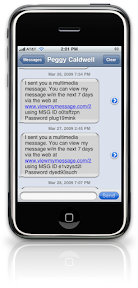 So, I understand that Apple purports to have good reasons for not supporting MMS at the moment and that Apple plans to support MMS this summer for 3G and 3G S phones and AT&T seems to be proud of themselves for offering MMS for free on the iphone despite the fact that MMS is free with basic messaging with almost every other provider, but whatever. That's all well and good.
So, I understand that Apple purports to have good reasons for not supporting MMS at the moment and that Apple plans to support MMS this summer for 3G and 3G S phones and AT&T seems to be proud of themselves for offering MMS for free on the iphone despite the fact that MMS is free with basic messaging with almost every other provider, but whatever. That's all well and good.But, here's what pisses me off . . . aside the fact that MMS has been around a really long time and that the iPhone is one of the few phones that doesn't support it, I'm still really annoyed by the way AT&T . . . oh excuse me . . . at&t decided to hack together some form of MMS support.
If you don't have an iPhone, let me tell you how this goes. You get a text message. The text message links you to a simple at&t multimedia messaging page with text boxes for message id and password. Then, you enter your message id and password which are provided in the text message.
Now, if you don't have a computer handy and you want to view this message on your iPhone, you had better grab a pen, 'cause this message id looks something like this: esth9389uohh or 1ch309903hsuh or 47&75uck5r3411y3ffingb4d! How I'm expected to remember this, I don't know.
Then, the password is a little easier to remember. It's just two four letter words separated by a two digit number. So, why do I find this so frustrating? Well, simply because there is no reason under the sun to do this. There is absolutely no difference between my entering these codes manually and at&t tacking them onto the query string. In fact, if they did that, they could use longer keys and could make it harder to brute force.
Then, when I got an MMS message, I could just click the link and, lo and behold, there would be my message. I wouldn't have to try to write down the dumb message id and try to figure out if that l is a 1.
I've got a password for you at&t . . . epic69fail.

